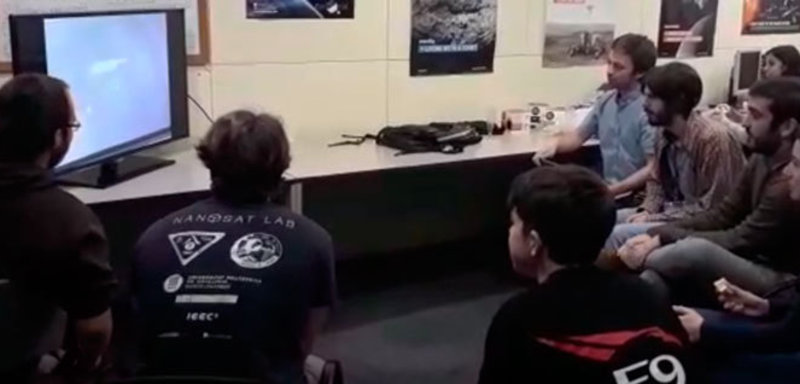The Catalan footprint in space
The Polytechnic University of Catalonia launches the CubeCat-1 nanosatellite into orbit carrying six experiments as part of an ongoing project designed and developed by students and researchers at the institution’s NanoSat Lab
CubeCat-1 is “the first of a new family of experimental small satellites” “Designing and testing CubeSats in the NanoSat Lab has been a unique experience”
The launch of CubeCat-1 took place in India, at the Satish Dhawan Space Center The nanosatellite is being tracked by the Montsec Astronomical Observatory
July will see the 50th anniversary of man first stepping foot on the Moon. Since that groundbreaking event happened, the interest in space has grown in parallel with the development of communications and technology that are increasingly capable of providing us with ever more details about what lies beyond our planet.
In fact, since the end of November, a Catalan device has been orbiting the Earth. It is a small satellite, or nanosatellite, called CubeCat-1, which was developed at Catalonia’s Polytechnic University (UPC), and which is carrying six experiments to be tested in space. The nanosatellite was made by the Nano-Satellite and Payload Laboratory (NanoSat Lab) of the Barcelona School of Telecommunications Engineering (ETSETB), a pioneering laboratory that is developing and experimenting with small satellites for educational purposes, research and testing technologies and applications in space. It is a unique facility in Europe that brings together in one place the instrumentation needed for testing space components and technology.
The launch of the CubeCat-1 nanosatellite took place in India, specifically at the Satish Dhawan Space Center, on the island of Sriharikota. Launched into orbit by the Polar Satellite Launch Vehicle, CubeCat-1 was one of 30 satellites from eight different countries. The launch of the small satellite was fully funded by the Institute of Space Studies of Catalonia (IEEC).
The nanosatellite is being tracked in its orbit by the Montsec Astronomical Observatory (in Sant Esteve de la Sarga, in Lleida), a government facility managed by the IEEC.
One of the new technologies that CubeCat-1 will test is a graphene transistor developed by the KTH Royal Institute of Technology in Stockholm, Sweden. Transistors are components made of silicon found in most everyday electrical devices. In computing, graphene transistors allow for the development of computers that can process at high speed, and can be produced at relatively low cost. The graphene experiment carried by the Catalan nanosatellite will test how graphene behaves under the aggressive conditions of space.
Another project will analyse the effects of highly charged energy particles through a commercial Geiger counter, an instrument that measures radioactive particles and ionising radiation. The same counter will also measure the impact of radiation on the other experiments carried by the nanosatellite. One of those experiments involves a microelectromechanical resonant system that will be used to measure, for the first time in situ, how monatomic oxygen attacks a polymer of interest for use in electronic applications. This experiment is important, as monatomic oxygen is very reactive and is present in low level orbit. On board the nanosatellite a new system of gathering environmental energy will be tested, which was created by the NanoSat Lab, and a new technology for wirelessly transmitting energy in space. The sixth experiment involves a camera that can capture images of the Earth from space.
The precedent
Previous to the launch of CubeCat-1, there was already a similar initiative. In August 15, 2016, the CubeCat-2 was launched from the Chinese base of Jiuquan. This seven-kilo device carried three experiments aimed at demonstrating the viability of different technologies linked to the use of signals in satellite navigation systems, such as GPS, Galileo and Glonass.
Despite this precedent, the UPC insists the CubeCat-1 is “the first of a new family of experimental small satellites,” which are based on the CubeSat standard. The CubeSat nanosatellites are small devices (made up of a combination of 10cm wide cubes) that weigh between one and ten kilos and that, thanks to the use of standardised commercial components, can be developed by groups of university students as well as researchers. The ambitious project to design, manufacture and test this family of CubeSat devices was carried out over a period of seven years at the NanoSat Lab, with support from the IEEC. According to Adriano Camps, professor at the lab’s Signal Theory and Communications Department, “designing, building and testing CubeSats in the NanoSat Lab has been a unique and very enriching experience.” “I am very happy with having helped to train and develop dozens of engineers that have integrated just about all elements of telecommunications and electronics into a cubic decimetre,” he adds. For his part, Ignasi Ribas, the IEEC head, says: “For years at the IEEC we have been working in the world of nanosatellites, as we believe it is a sphere that is expanding and there is a demand for them to help democratise access to space.”
technology




